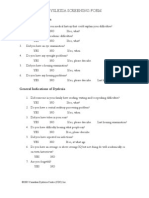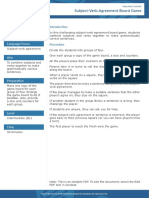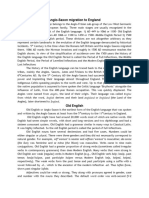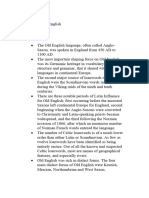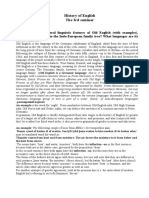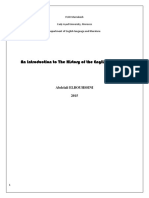Report Assignment
Uploaded by
re.designer.maReport Assignment
Uploaded by
re.designer.maFull name: ELHAOUZI Roqaya
Master: Linguistics & Advanced English Studies
Module: Old English
Supervised by: Pr. Abdellah Elhaloui
Report of “Beginning Old English” book from pages 81 to 93
This report covers the topics discussed from pages 81 to 93 of “The Beginning of Old
English” book by Carole Hough and John Corbett. To begin with, it is stated that the verb ‘to
be’ is originally derived from two Old English verbs, which are wesan and beōn. The second
form, beōn, in today’s English, is only found in the infinitive ‘to be’ while all of the other
forms of today’s ‘verb to be’ come from wesan. However, there is a possibility that in Old
English wesan and beōn had slightly different meanings. One is referring to the present
while the other was used to refer to ‘timeless facts’. For example, sentences like ‘I be the
king’s huntsman’ express timeless facts. It is like saying in today’s English ‘I am the king’s
huntsman’. Using wesan and beōn with present participle to show duration was not
common in Old English. Therefore, phrases like feohtende wǣron (were fighting) would be
translated to ‘continued fighting’.
Furthermore, we explore how the present-day English system is an extension of the
Old English system which is similar but not identical to the one we have today. Present-day
English uses combinations made up of the verb ‘to have’ to indicate specific references to
time as in ‘He has fought’ and ‘He had fought’. The meaning is determined depending on the
verb used and the context in which it is used, for it can indicate up to three meanings. Now,
we see how was the case in Old English as far as the verb ‘to have’ is concerned. Old English
used a set of combinations with both habban and beōn. Habban was used in sentences in
which the verb is associated with an Object while beōn was used the verb is not associated
with an Object. For instance, in this sentence ‘hē hæfþ þone fēond gefeohtan’(he has fought
the enemy), habban is used because the verb ‘gefeohtan’ has an object which is ‘þone
fēond’ (the enemy). However, sometimes Old English writers would use simple present-
tense forms in sentences that express duration. The book also provides a poem called The
Dream of the Rood to show the first-person narrative in which the speaker is an actor in his
own story. In this poem, the narration switches from the first person to the third person and
vice versa.
One of the features of Old English is the tendency to separate plural subjects and to
give them a singular verb. In today’s English, we would say something like ‘Beowulf and his
comrades’, but in Old English, it would be more like, ‘Beowulf laid his head on the pillow,
and his comrades likewise’. Asking questions in Old English, moreover, is similar but easier
than Modern English in the sense that in yes/no questions the order of subject and verb is
simply reversed without adding the auxiliary verb ‘do’. Also, Old English used ne and nā to
form negative sentences. Sometimes, both of them could be used in one sentence to stress
the negative meaning, and ne can be attached to some verbs to form a single word. As for
commands, Old English commands can be either for an individual, as in the verb form gā, or
for a group, as in gāþ. In Old English, there are so many verbs that have impersonal uses in
which there is no animate subject, especially verbs expressing mental events or perceptions.
Finally, the passive voice in Old English is constructed in a similar way to today’s English as in
‘Peohtas wǣron gefullode’.
You might also like
- HUGE List of Therapy Task Ideas For Adult Speech Therapy100% (1)HUGE List of Therapy Task Ideas For Adult Speech Therapy7 pages
- Phonetic Transcriptions of Pimsleur Level 1 Lessons 1No ratings yetPhonetic Transcriptions of Pimsleur Level 1 Lessons 119 pages
- Book Excerpt: 'If I Survive You' by Jonathan Escoffery100% (1)Book Excerpt: 'If I Survive You' by Jonathan Escoffery3 pages
- How To Make Millions With Your Ideas: An Entrepreneurs Guide Download Free BookNo ratings yetHow To Make Millions With Your Ideas: An Entrepreneurs Guide Download Free Book4 pages
- Five Phonological and Phonemic Awareness Activities: Page - 1No ratings yetFive Phonological and Phonemic Awareness Activities: Page - 110 pages
- Read Online: Woe Is I: The Grammarphobe's Guide To Better English in Plain English, 3rd Edition by Patricia T. O'Conner33% (3)Read Online: Woe Is I: The Grammarphobe's Guide To Better English in Plain English, 3rd Edition by Patricia T. O'Conner5 pages
- Free Kindergarten Reading Comprehension Summer Edition100% (3)Free Kindergarten Reading Comprehension Summer Edition5 pages
- Wollen Peter Signs and Meaning 1969 1972No ratings yetWollen Peter Signs and Meaning 1969 1972186 pages
- Win 'Wine', Cyse 'Cheese', Catte 'Cat', Cetel 'Kettle', Disc 'Dish' Candet 'Candle'. OtherNo ratings yetWin 'Wine', Cyse 'Cheese', Catte 'Cat', Cetel 'Kettle', Disc 'Dish' Candet 'Candle'. Other11 pages
- Historia de La Lengua Inglesa EXPO Grupo 6No ratings yetHistoria de La Lengua Inglesa EXPO Grupo 621 pages
- Characteristics of Old English: Northumbrian, Mercian, West-Saxon Kentish West-Saxon Became The Most ImportantNo ratings yetCharacteristics of Old English: Northumbrian, Mercian, West-Saxon Kentish West-Saxon Became The Most Important14 pages
- Old Norse For Beginners - Lesson One: by Haukur Þorgeirsson and Óskar GuðlaugssonNo ratings yetOld Norse For Beginners - Lesson One: by Haukur Þorgeirsson and Óskar Guðlaugsson11 pages
- What Are The Origins of The English LanguageNo ratings yetWhat Are The Origins of The English Language5 pages
- Unit 2. the Old English Period (Activities)No ratings yetUnit 2. the Old English Period (Activities)5 pages
- Shortened CM2 - Hist of English L L - Old EnglishNo ratings yetShortened CM2 - Hist of English L L - Old English5 pages
- Beowulf: Language and Poetics Quick Reference SheetNo ratings yetBeowulf: Language and Poetics Quick Reference Sheet4 pages
- Old English Language Beowulf in Old EnglishNo ratings yetOld English Language Beowulf in Old English4 pages
- Essay How Did Germanic Culture Influence The English LanguageNo ratings yetEssay How Did Germanic Culture Influence The English Language4 pages
- Grammatical Structures of English Module 01100% (2)Grammatical Structures of English Module 0159 pages
- Phonetic System: Manuscripts Which Have Survived The Ravages of Time. These Manuscripts Reflect ANo ratings yetPhonetic System: Manuscripts Which Have Survived The Ravages of Time. These Manuscripts Reflect A9 pages
- Linguistic Features of The Old English Period100% (3)Linguistic Features of The Old English Period5 pages
- How Modern English Is Different From Old English100% (1)How Modern English Is Different From Old English3 pages
- How Did The Nordic Language Change The English LanguageNo ratings yetHow Did The Nordic Language Change The English Language10 pages
- Name: Yun Angraeni Saputri Reg. Number: G2Q118001 Subject: ModernNo ratings yetName: Yun Angraeni Saputri Reg. Number: G2Q118001 Subject: Modern5 pages
- Diacronía Del Inglés - The Egiptian DaysNo ratings yetDiacronía Del Inglés - The Egiptian Days5 pages
- Characteristics of Old English LanguageNo ratings yetCharacteristics of Old English Language11 pages
- Valles, J. HISTORY OF ENGLISH. (Corregido)No ratings yetValles, J. HISTORY OF ENGLISH. (Corregido)16 pages
- An Introduction To The History of The enNo ratings yetAn Introduction To The History of The en17 pages
- The History of English (2023 - 04 - 13 15 - 30 - 03 UTC)No ratings yetThe History of English (2023 - 04 - 13 15 - 30 - 03 UTC)6 pages
- Literatura Inglesa I - Old English LiteratureNo ratings yetLiteratura Inglesa I - Old English Literature108 pages
- Teaching Reading Comprehension Using Discovery Learning Method in Narrative TextNo ratings yetTeaching Reading Comprehension Using Discovery Learning Method in Narrative Text7 pages
- Objectives: 5. Topic References MaterialsNo ratings yetObjectives: 5. Topic References Materials6 pages
- M-CHAT Scoring Key: Does Your Child Take An Interest in Other Children?No ratings yetM-CHAT Scoring Key: Does Your Child Take An Interest in Other Children?1 page
- American Comic Books Versus Japanese MangaNo ratings yetAmerican Comic Books Versus Japanese Manga1 page
- Instant ebooks textbook (Ebook) Fatherless Sons: Healing the Legacy of Loss by Jonathan Diamond Ph.D. ISBN 9780471219699, 047121969X download all chapters100% (4)Instant ebooks textbook (Ebook) Fatherless Sons: Healing the Legacy of Loss by Jonathan Diamond Ph.D. ISBN 9780471219699, 047121969X download all chapters71 pages
- Deadpool Kills The Marvel Universe #001 (2012)No ratings yetDeadpool Kills The Marvel Universe #001 (2012)23 pages
- Chapter 3, Review of Related LiteratureNo ratings yetChapter 3, Review of Related Literature32 pages
- 1 - PFHL 210 - Good Local Church Goals - ETRSNo ratings yet1 - PFHL 210 - Good Local Church Goals - ETRS1 page
- Making Learning Whole: How Seven Principles of Teaching Can Transform Education100% (1)Making Learning Whole: How Seven Principles of Teaching Can Transform Education2 pages
- (Ebook) You Can Draw in 30 Days: The Fun, Easy Way to Learn to Draw in One Month or Less by Kistler, Mark ISBN 9780738212418, 0738212415 instant download100% (1)(Ebook) You Can Draw in 30 Days: The Fun, Easy Way to Learn to Draw in One Month or Less by Kistler, Mark ISBN 9780738212418, 0738212415 instant download61 pages
- Scandinavian Journal of The Old Testament: An International Journal of Nordic TheologyNo ratings yetScandinavian Journal of The Old Testament: An International Journal of Nordic Theology23 pages
- The Picture of Dorian Gray and Character LooksNo ratings yetThe Picture of Dorian Gray and Character Looks4 pages
- Instant ebooks textbook (Ebook) Tutorials in Introductory Physics: Homework (CU Boulder Edition) by Lillian C. McDermott; Peter S. Shaffer ISBN 9781269320146, 1269320149 download all chapters100% (1)Instant ebooks textbook (Ebook) Tutorials in Introductory Physics: Homework (CU Boulder Edition) by Lillian C. McDermott; Peter S. Shaffer ISBN 9781269320146, 1269320149 download all chapters76 pages
- A Course of Practical Organic Chemistry - Price and Twiss 1907No ratings yetA Course of Practical Organic Chemistry - Price and Twiss 1907263 pages







